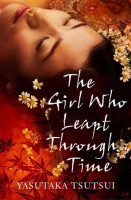 Author: Yasutaka Tsutsui
Author: Yasutaka Tsutsui
Translator: David Karashima
U.K. publisher: Alma Books
ISBN: 9781846881343
Released: May 2011
Original release: 1967
One of my favorite animated films is Mamoru Hosoda’s 2006 The Girl Who Leapt Through Time which was inspired by Yasutaka Tsutsui’s short novel The Girl Who Leapt Through Time, originally released in Japan in 1967. Tsutsui is an award-winning and extremely well-known author of Japanese science fiction, though Western audiences are probably more familiar with the various anime and live-action adaptations of his works. The Girl Who Leapt Through Time is one of Tsutsui’s most beloved and popular stories. It has been the basis for several television series, films, and manga in addition to Hosoda’s anime. The novel, translated by David Karashima, was released in English by UK-based publisher Alma Books in 2011. The English edition of The Girl Who Leapt Through Time is based on the 2009 republication of the volume which collects Tsutsui’s story The Stuff That Nightmares Are Made Of as well as The Girl Who Leapt Through Time.
The Girl Who Leapt Through Time was originally serialized between 1965 and 1966 before being collected in 1967. The titular girl, Kazuko, discovers that she has gained the ability to slip through time and space after fainting in her high school’s science lab. Although the power has its advantages, it’s not one that she wants. She wishes that her life would go back to normal and that her two closest friends and classmates, Goro and Kazuo, would be able to treat her in the same way that they always have. Initially Goro is skeptical of Kazuko’s newfound ability, at least until she is able to offer him proof. The more laid back Kazuo on the other hand takes the whole situation in stride; at first he doesn’t seem to be bothered by it at all. The Girl Who Leapt Through Time is a charming story, but I will admit that I largely prefer the anime’s version of the tale. Many of the scenes are similar between the two, but the novel is much simpler and more direct. Even so, I can understand why Tsutsui’s original has inspired so many other creators—it’s imaginative science fiction with just the right touch of romance.
Whereas The Girl Who Leapt Through Time is science fiction, The Stuff That Nightmares Are Made Of leans more towards realistic psychological horror. The story follows Masako, a young woman who has started to avoid visiting her friend Bunichi’s household, though she can’t quite recall the reason why she has been staying away. After helping to dispel some of the fears of her younger brother—showing that his wild imaginings are rooted in real world happenings—she decides to face and investigate the causes of her own. Initially Bunichi teases Masako, but realizing that she really is frightened he agrees to accompany her on her mission, getting quite a scare in the process. Considering the short length of The Stuff That Nightmares Are Made Of, Tsutsui is able to incorporate an impressive number of story twists. Masako is an appealing lead—smart and clever, though perhaps a little reckless and with room to grow and mature. Her willingness to confront her fears and to improve herself is admirable, but it can also cause some problems for her and the people around her, too.
Although The Girl Who Leapt Through Time and The Stuff That Nightmares Are Made Of are two, unrelated stories, they do share some similarities. The protagonists are both intelligent, likeable young women, for one. Tsutsui’s style has a subtle, understated humor to it and the writing is simple and straightforward, making both stories approachable for younger readers. Each of the tales has a bit of romance in addition to a quickly paced plot. (The entire volume can fairly easily be read in one or two sittings.) But what I found to be the most striking commonality and difference between The Girl Who Leapt Through Time and The Stuff That Nightmares Are Made Of was Tsutsui’s use of and approach to the themes of memory and truth. Both are important elements in the two stories, but are handled oppositely: The Girl Who Leapt Through Time carries a sense of nostalgia over the loss of memory, the truth ultimately being hidden while in The Stuff That Nightmares Are Made Of it is only after a particular memory is regained that the truth is completely revealed.




